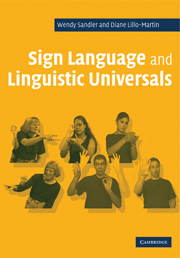Book contents
- Frontmatter
- Contents
- Preface
- Notation conventions
- UNIT I INTRODUCTION
- UNIT II MORPHOLOGY
- 2 Morphology: introduction
- 3 Inflectional morphology
- 4 Derivational morphology
- 5 Classifier constructions
- 6 Entering the lexicon: lexicalization, backformation, and cross-modal borrowing
- 7 Morphology: conclusion
- UNIT III PHONOLOGY
- UNIT IV SYNTAX
- UNIT V MODALITY
- References
- Index
5 - Classifier constructions
Published online by Cambridge University Press: 05 June 2012
- Frontmatter
- Contents
- Preface
- Notation conventions
- UNIT I INTRODUCTION
- UNIT II MORPHOLOGY
- 2 Morphology: introduction
- 3 Inflectional morphology
- 4 Derivational morphology
- 5 Classifier constructions
- 6 Entering the lexicon: lexicalization, backformation, and cross-modal borrowing
- 7 Morphology: conclusion
- UNIT III PHONOLOGY
- UNIT IV SYNTAX
- UNIT V MODALITY
- References
- Index
Summary
There is a rich and complex morphological system in all sign languages we know of that is used for the purpose of denoting spatial relations and motion events and for characterizing shapes and dimensions of objects. The system utilizes forms representing different classes of nominals in combination with other elements. The noun class forms are represented by a set of handshapes, and it is these handshape units that are commonly called classifiers in the sign language literature.
Classifier constructions represent a pervasive but somewhat anomalous subsystem in sign language grammars. Their form, though morphologically complex, is different from that of complex lexical words, and, although classifier constructions may translate as whole propositions, they are not formally like ordinary sentences either. Classifier constructions often capitalize on iconicity, which has led some researchers to question the linguistic status of these forms. The view we present here characterizes classifier constructions as a linguistic system that bears certain significant similarities to verbal classifier constructions in spoken languages, a comparison we develop in detail. But we do not lose sight of the uniqueness of the sign language system. We exemplify its special properties with an analysis of the way classifier handshapes and the coordinate predicate structures they may enter into are extended artistically in sign language poetry.
- Type
- Chapter
- Information
- Sign Language and Linguistic Universals , pp. 76 - 93Publisher: Cambridge University PressPrint publication year: 2006
- 1
- Cited by



